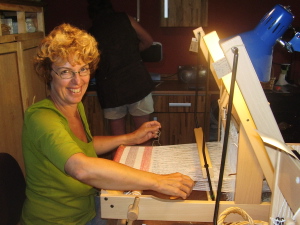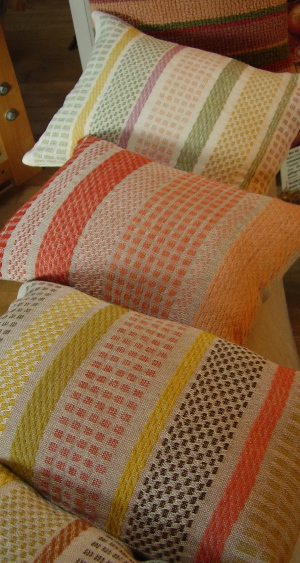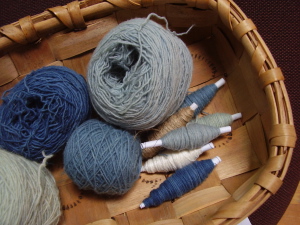 This blog post is a plug for the special 5-day intensive weave course taught in Spanish (suitable for intermediate-level and above Spanish speakers), at the Textile Studio in Cristosende, A Teixeira, in north Spain, in July 2010. You won´t be offered any Spanish classes during the course (although Anna will always translate when necessary) but you will be immersed in a Spanish-speaking environment and surrounded by the Spanish language… What is more, this holiday craft option in Spain will enable you to learn the creative art of weaving textiles on a loom by hand! You´ll be very proud of your first hand-woven textile – woven “in Spanish”!
This blog post is a plug for the special 5-day intensive weave course taught in Spanish (suitable for intermediate-level and above Spanish speakers), at the Textile Studio in Cristosende, A Teixeira, in north Spain, in July 2010. You won´t be offered any Spanish classes during the course (although Anna will always translate when necessary) but you will be immersed in a Spanish-speaking environment and surrounded by the Spanish language… What is more, this holiday craft option in Spain will enable you to learn the creative art of weaving textiles on a loom by hand! You´ll be very proud of your first hand-woven textile – woven “in Spanish”!
About the studio and venue: Anna Champeney specialises in weaving traditional Galician Spanish folk textiles and designing her own range of limited-edition textile designs for scarves and interiors. Together with her partner, Lluis Grau, Anna has been offering Spanish craft holidays and self-catering cottage holidays since 2004.
About loom weaving: Many people who watched Monty Don´s Mastercrafts series on weaving earlier this year in March 2010 on television in the UK will have been fascinated and inspired by the fabrics woven by the 3 contestants over a 6 week period! The art of weaving cloth by hand from the beginning is a magical and very satisfying experience. Unlike some “hobby crafts” loom weaving is not a craft that offers easy and quick satisfaction (the setting up of the loom requires patience and care) but it is a craft which can become addictive once the basics have been mastered and offers infinite creative possibilities. The rythmic experience of weaving is immensely satisfying and also relaxing! As opposed to knitting, weaving requries two sets of threads – the warp (set up under tension on the loom) and the weft (which is wound onto a bobbin and interwoven through the warp on a shuttle). The first part of learning to weave involves setting up the warp threads on the loom and the second part is the actual weaving in the weft threads on a shuttle. The loom itself is what enables weavers to weave many different patterns and even complete beginners will be able to weave at least 3 different patterns.
 About the Ribeira Sacra in Galicia, Spain: The Ribeira Sacra, where the Textile Studio is situated, is a rural area of outstanding natural beauty in Galicia, north Spain, which centres on the River Sil canyon, with its steep terraces of vineyards (D.O. Ribeira Sacra). The climate is not as hot as in southern Spain and the area retains its green-ness even in the heat of summer, with its forests of sweet chestnuts.
About the Ribeira Sacra in Galicia, Spain: The Ribeira Sacra, where the Textile Studio is situated, is a rural area of outstanding natural beauty in Galicia, north Spain, which centres on the River Sil canyon, with its steep terraces of vineyards (D.O. Ribeira Sacra). The climate is not as hot as in southern Spain and the area retains its green-ness even in the heat of summer, with its forests of sweet chestnuts.
Loom weaving course details:
Dates: 4 – 8 July 2010
Location: Anna Champeney Estudio Textil, Cristosende 76-78, A Teixeira (Ribeira Sacra), Ourense, Galicia, Spain
Course Outline:
- Loom preparation (each participant has the exclusive use of a 4 or 8 shaft Louet table loom during the course and there are special discounts to pupils who wish to purchase a loom after the course)
- Weave samples – different patterns, colours and yarns
- Creative Weaving I: The Design Process, Experimentation, Obervation and Analysis
- Creative Weaving II: Understanding pattern drafts and project sheets
- Weave final project piece (fabric for cushion cover, linen towel, bathroom, wall-piece or kitchen bag ….)
Cost: (includes materials and teas/coffees, excludes accommodation and travel): 390€ (approximately 351 pounds stirling (correct at the time of writing))
Accommodation options: 5 accommodation places in individual / shared rooms are available at Casa dos Artesans (awarded the Spanish mact quality symbol), some 30 metres from the Textile Studio. Shared rooms (2 people) – 30€ per night / Individual rooms – 45€ per night. The Casa Grande de Cristosende (rural hotel and restaurant in the same village as the Textile studio) has rooms from approximately 65€ per night. Further information about other accommodation options on request.
How To Get Here: Fly to Santiago de Compostela (flights available from Stanstead or Heathrow) and hire a car or travel on by direct coach service to Ourense city (we facilitate a time-table when you book on the course) from where a transfer is available to the Textile Studio. Alternatively, fly to Madrid and take the train / coach to Ourense or Monforte de Lemos (where a transfer service to the Textile Studio is available).
You may also be interested in the following options- Self-catering cottage holidays in the Ribeira Sacra for 2 – 5 people (additional craft activities available in Spanish or English) / 3-week Textile Assistantship in the Ribeira Sacra / Basketry and Weaving Tuition in the Ribeira Sacra / Otros cursos de artesanía en español


 Some new cushions are available from the AC Textile Studio. Some of the “Spots & Squares” cushions are commissioned pieces and have been sent on by post. As hand-weavers, we are often asked the question “why weave textiles by hand”. One simple answer is that, unlike industry, we are able to personalize textiles for clients with individually-chosen colourways (even if we don´t actually colour-match colours). Some clients feel unsure about choosing colour schemes themselves and welcome some support and advice, but many find that choosing the colours for “their” cushion is really fun and becomes part of the “craft experience”. It certainly gives the finished cushion – especially if it is for a new home or ordered as a gift – a whole new meaning and significance than a cushion bought “off-the-peg”, however pretty it may be. Commissioning textiles whilst on holiday here in north Spain is an extra special option for guests who come on holiday to Casa dos Artesans, our self-catering craft cottage, which is just a short stroll from the textile studio itself.
Some new cushions are available from the AC Textile Studio. Some of the “Spots & Squares” cushions are commissioned pieces and have been sent on by post. As hand-weavers, we are often asked the question “why weave textiles by hand”. One simple answer is that, unlike industry, we are able to personalize textiles for clients with individually-chosen colourways (even if we don´t actually colour-match colours). Some clients feel unsure about choosing colour schemes themselves and welcome some support and advice, but many find that choosing the colours for “their” cushion is really fun and becomes part of the “craft experience”. It certainly gives the finished cushion – especially if it is for a new home or ordered as a gift – a whole new meaning and significance than a cushion bought “off-the-peg”, however pretty it may be. Commissioning textiles whilst on holiday here in north Spain is an extra special option for guests who come on holiday to Casa dos Artesans, our self-catering craft cottage, which is just a short stroll from the textile studio itself. Further Information:
Further Information:



All About Tabby Kittens and Plainweave Cloth Weaving – Weaver Anna Champeney reports
PRONUNCIATION:
(TAB-ee)
MEANING:
noun: 1. A domestic cat with a striped or brindled coat, or a fabric of plain weave or a watered silk fabric
ETYMOLOGY: From French tabis, from Medieval Latin attabi, from Arabic attabi, from al-Attabiya, a suburb of Baghdad, Iraq, where silk was made, from the name of Prince Attab.
All this means, logically, that tabby cats should be the natural choice for weavers, in which case, boy, am I a lucky weaver!!!?? For our pet cat Tangula, who as you might remember was just a kitten when I started writing this blog last year (click here to see a blog post with a photo of Tangula when still a kitten last year), is now the proud mother of no fewer than FIVE BEAUTIFUL TABBY KITTENS. Two will be staying in the village of Cristosende, just moving a few doors down to Debs´ house. But if you can provide a loving home for one or two of the others and live within driving distance of the Ribeira Sacra, Ourense, Galicia – then – look no further for your kittens. Just contact us. They will be ready for adoption by the end of June 2010, and are already toilet trained because Tangula, despite her tender age – is proving to be an excellent, if slightly stressed out, mother!
Whilst on the subject of kittens, you might find my training tips quite useful – they´re not just for weavers or knitters!
TRAINING TIPS FOR KITTENS – HOW TO EDUCATE YOUR MOG IN THE HOME OR CRAFT WORKSHOP
(Below are 3 photos of the beautiful kittens ready for adoption in Ourense, Galicia, Spain – June 2010)
Having a new kitten – especially but not exclusively in a weave workshop – presents some, erm, rather obvious hazards. Linen shawls with fringes are a temptation that no kitten can resist; and yarns, whether in skeins, balls or on cones – are, for cats, obvious proof of their owners “desire to play”.
I have had a few initial disasters in my weaving studio with cats, yarns and (aaghhh) fine, hand-woven linen shawls, but they have taught me some useful lessons and made me explore useful training methods. I have written them down here in my blog so that you won´t have to ban your mog from your studio (or bedroom or living room!). Of course, in addition to training your kitten, you will also find as he or she grows older and “more responsible” they won´t find playing with your hand-wovens such a temptation.
I have discovered is that it is perfectly possible to train a cat not to destroy either your yarns or hand-woven scarves (and by extention your sofa or bedcover or favourite cushion!). I can now allow both our adult cats into my workshop and shop, where linen shawls with fringes are well within cat paw height – and have no problems. All it requires is a bit of patience as kittens need to learn what is acceptable – and unacceptable – behaviour. A bit of perseverance when the kitten is young will be rewarded later on, when you can enjoy the purr of a dozing cat whilst you weave.
1. Keep a plant spray handy and stay alert. A light spray of water when kitty starts to “play” with your yarns is enough to persuade him or her that it´s not such a good idea – without causing any hurt.
2. Engineer noisy “accidents” which put cats off jumping up onto display areas, shelves, tables etc., where you don´t want them to go. Once one of our cats jumped onto a textile display area and managed to pull a display bust over, with several textiles. The resultant clatter, as both bust and cat went down together, was actually very effective shock therapy and he never jumped up to cause problems again. With a young cat or you can re-create this kind of happening – but less destructive, (to the display bust and textile and cat) – for example – by contructing a tower of empty toilet rolls with some jamjar lids – which will persuade him or her that it´s not such a good idea to jump onto that particular surface. One cat training book suggests placing one or several traditional mousetraps, upside down, with a cloth over them, so that when a cat jumps up it jumps shut with a loud snap – this is enough to make your cat “jump” and move off the surface.
4. The best way to train cats to avoid particular places to sleep (like on your sofa or yarn box or on a pile of recently ironed shawls or scarves) is by creating a place they like even better. For cats are creatures of habit and once they´ve found their “favourite” place to sleep they will return again and again. A bit of trial and error may be necessary in order to find a location they like (cats often feel more secure off the floor in a higher area) and the kind of surface (one cats usually have a preference for natural fibres).
Weaving Courses and Self-Catering Cottage Holidays with us in north Spain
Adopt one of our kittens